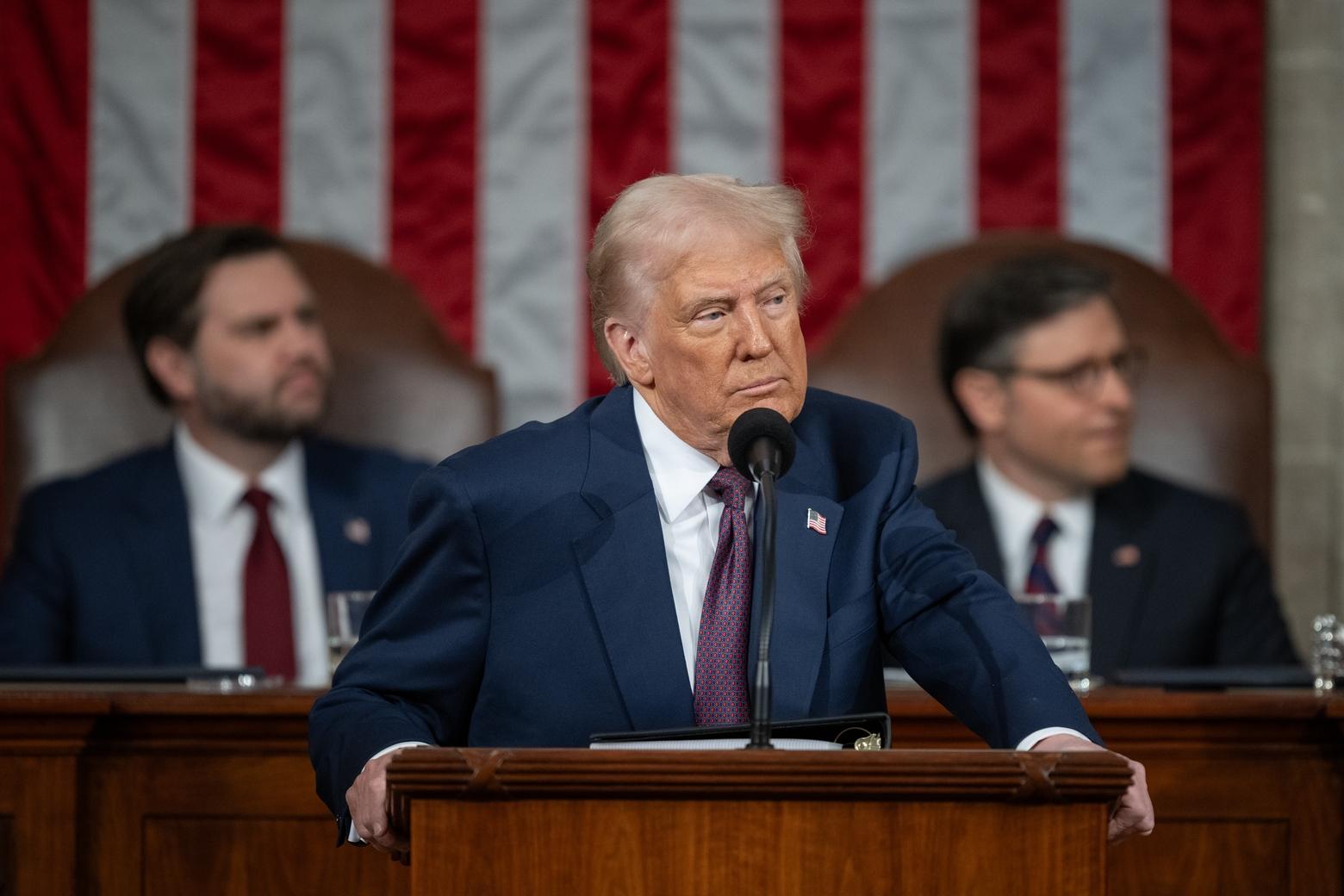Back to StoriesTrump Budget Proposal Portends Deep Cuts to Public Lands
May 5, 2025
Trump Budget Proposal Portends Deep Cuts to Public LandsRecommendations include new consolidated wildfire service, more tasks in state hands, less science
by Robert Chaney
Taking aim at “climate ideologies antithetical to the American way of life,” President Donald Trump’s proposed 2026 federal budget would reduce spending on public lands, shift some national park facilities and forest management to states, and consolidate federal wildland firefighting into a new service inside the Department of the Interior.
Trump wants to spend approximately $1.7 trillion next year, with $1.1 trillion of that going to military defense. Overall, the proposal reduces non-defense discretionary federal spending by $163 billion, or 22.6 percent compared to last year. At the same time, it allocates $175 billion in new spending for the Department of Homeland Security to “at long last, fully secure our border,” according to the budget proposal.
If Congress approves the proposed budget, the cuts would go into effect on October 1, 2025, when the federal fiscal 2026 budget year begins. However, Congress has routinely rejected controversial elements of presidential budgets from both Republican and Democratic administrations. Trump’s proposal would bring domestic spending to its lowest level in decades.
Those cuts could have particular impact on the Rocky Mountain West, where the federal government oversees huge swaths of national forests and grasslands, underground mineral resources, parks and wildlife refuges, and vital public infrastructure.
The Interior Department would take an overall $3.8 billion reduction from its 2025 budget of $18 billion. That includes a $1.2 billion cut to National Park Service operations, $724 million from the Bureau of Indian Affairs, $564 million from the U.S. Geological Service, and $207 million from the U.S. Fish and Wildlife Service.
However, the Trump “skinny budget” released on Friday does not offer a dollar figure for its proposed Federal Wildland Fire Service. Its Interior Department section recommends combining five existing firefighting agencies into one, citing “significant coordination and cost inefficiencies that result in sub-optimal performance … to combat the wildfire crisis.” While the recommendation echoes many of the suggestions found in a draft executive order for a consolidated wildfire service circulating in March, it does not mention that document’s call for full suppression of all wildfires.
The Department of Agriculture had a $132 billion budget in 2025. That included $5.7 billion for the Forest Service. Trump’s budget recommends $4.7 billion in cuts department-wide, including $1.4 billion from Forest Service activities and research.
On Friday morning, Office of Management and Budget Director Russell Vought sent the preliminary budget letter to Senate Appropriations Committee Chairwoman Susan Collins, R-Maine.
“The recommended funding levels result from a rigorous, line-by-line review of [fiscal year] 2025 spending, which was found to be laden with spending contrary to the needs of ordinary working Americans and tilted toward funding niche non-governmental organizations and institutions of higher education committed to radical gender and climate ideologies antithetical to the American way of life,” Vought wrote in the letter. “We also considered, for each program, whether the governmental service provided could be provided better by State or local governments (if provided at all).”
Trump’s budget recommends $4.7 billion in cuts to the USDA, including $1.4 billion from Forest Service activities and research.
The proposal does not appear to include an anticipated suggestion to sell or transfer federal lands. But in its Department of Housing and Urban Development section, the Trump plan calls for a new state-based rental assistance program that “In combination with efforts related to opening up Federal lands … would incentivize States and the private sector to provide affordable housing.”
The Environmental Protection Agency would see a $4.2 billion reduction, amounting to 54.2 percent of its 2025 budget.
In its National Park Service proposals, the letter calls for prioritizing work at “crown jewel national parks,” but also recommends “transferring smaller, lesser visited parks to State and tribal governments.” While no parks are mentioned by name, Yellowstone National Park and Grand Teton National Park are among the nation’s top tourist destinations, while places like Little Bighorn National Battlefield or Red Rock Lakes National Wildlife Refuge might qualify for transfer to state control.
“The President has pledged to manage national forests for their intended purpose of producing timber,” the letter states, adding that the proposed budget would reduce spending where it is “out of step with the practical needs of forest management for timber production.”
The USDA section of the proposal also envisions “restoring federalism by empowering States to assume a greater role in managing forest lands within their borders.” But it reduces Forest Service salaries by $342 million, eliminates the Collaborative Forest Landscape Restoration Program’s $50 million allocation, and reduces “funding for recreation, vegetation and watershed management, and land management regulation.”
The proposed budget cites “allegations of impropriety” to justify taking $303 million away from State, Local, Tribal and NGO Conservation programs, adding, “these partners should be encouraged to fund their own community preparedness and risk mitigation activities.”
USDA would see increases of $15 million for the Food Safety Inspection Service and $74 million for Rental Assistance Grants. But a number of its other agriculture-related services would take cuts. Those include $358 million from the Farm Service Agency, $754 million from the Natural Resource Conservation Service, $721 million from Rural Development, and $159 million from the Agricultural Research Service. It eliminates $602 million from the National Institute of Food and Agriculture, calling those initiatives “wasteful, woke programming … related to climate change, renewable energy and promoting DEI in education.”
The public lands provisions raised many questions among former Forest Service officials. Mary Erickson, recently retired supervisor of the Custer Gallatin National Forest, said she’d seen many presidential recommended budgets in her 45-year career, but “never one with so much political rhetoric in it.”
Former Helena-Lewis and Clark National Forest Supervisor Bill Avey added that some proposals seem to contradict their own intentions. For example, calls to increase timber production on federal lands come alongside cuts to federal timber managers. And the recommendations to give more state authority for timber production, park supervision and wildfire control occur in budget cuts to state programs.
“In Montana’s [Department of Natural Resources and Conservation], in fire they hire 180 firefighters,” Avey said. “The Forest Service puts 1,000 firefighters in Montana. The Forest Service traditionally had 5,000 employees. DNRC has less than 500. How are they going to manage more land? If you cut funding for the states, are you just going to pass that on to state taxpayers? It’s head-scratching.”
__________________________________________________________________________________________________
Mountain Journal is a nonprofit, public-interest journalism organization dedicated to covering the wildlife and wild lands of Greater Yellowstone. We take pride in our work, yet to keep bold, independent journalism free, we need the support of readers like you. Thank you.
Related Stories
February 26, 2025
Conservation Groups File Notice to Sue Feds Over New Gold Mine
The Stibnite project site would be the fourth-largest gold operation in the U.S. by grade, and the only domestic source of...
December 7, 2023
After 20 Years of Lawsuits, Wolverine Listed as Threatened
Wolverines face numerous threats and only 300 exist in the Lower 48. Now that the U.S. Fish and Wildlife Service listed...
January 24, 2025
Trump Energy Policy Aims to Unplug Endangered Species Act
Executive orders direct agencies to minimize consultations, giving priority to energy and mining permits.




